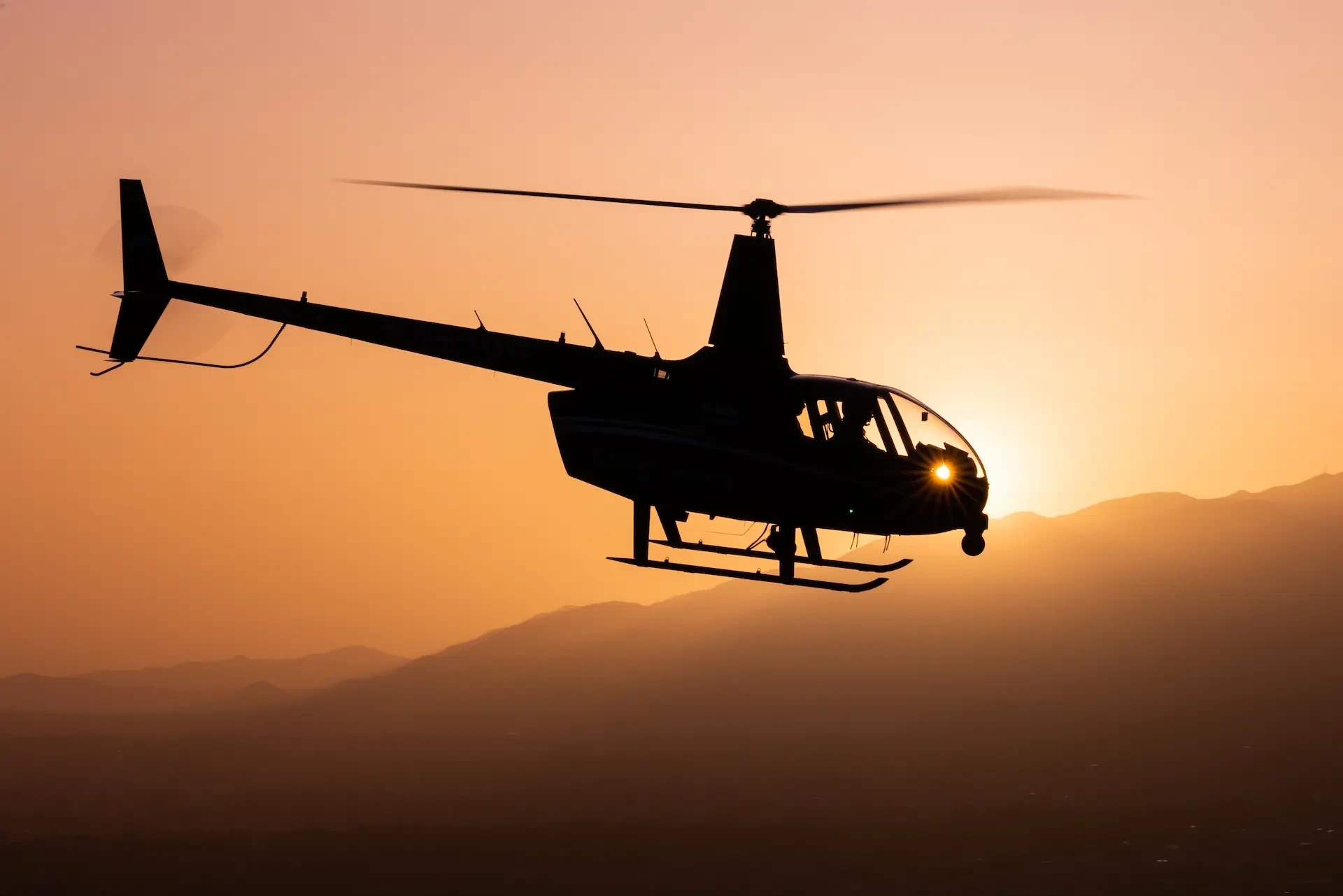The Fontana Police Department first started air support operations in the late nineties, when they contracted to provide officers to fly as TFOs (tactical flight officers) with the San Bernardino County Sheriff’s department aviation unit. The Fontana Police department air support unit then started its own stand-alone law enforcement aviation operation in 2005. Jimmy van Drunen met with Fontana’s pilots and TFOs to learn more about their missions, their aircraft, and the agency’s partnership with other law enforcement agencies.
The city of Fontana in San Bernardino County, California is home to more than 200,000 residents and operates a police department with about 188 sworn officers. The police air unit operates with two crew, one observer and one sergeant. Fontana’s helicopter base is at Bracket Field Airport, one mile (2km) southwest of La Verne, in Los Angeles County, California and it assists other agencies within San Bernardino County. The sergeant is in charge of paying the bills and putting out fires, primarily focused on the administrative side. Although there is currently only one TFO in the air unit, they are working on getting a couple of backup TFOs and then hopefully starting to expand the program and recruit more. Earlier in its history, the air unit had its own non-sworn civilian pilots. They abandoned that model and now contract HeliSafe to provide the pilots, maintain the helicopters and provide the hangars, while the city of Fontana owns the helicopters and the equipment. Fontana is the lead agency in a four-city alliance and started using a Robinson R44 in 2005. In 2011, the police department decided it wanted two helicopters, believing it could run a more responsive air patrol program for less money than it was then spending.
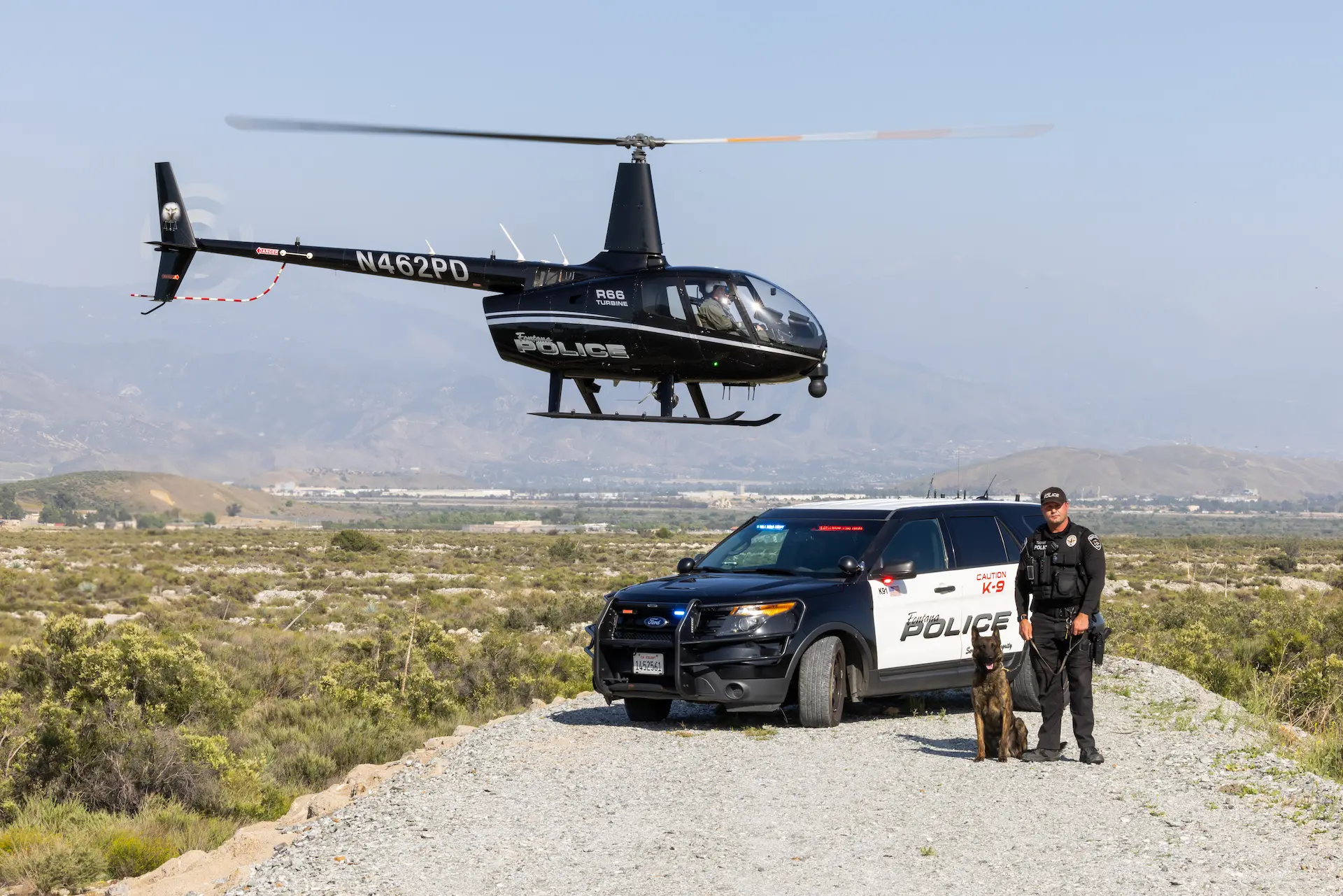
A new Robinson R44 outfitted for police work costs over US$800,000 but Robinson Helicopter Company had subsequently developed the later, more powerful turbine-engined R66 model, and the first R66 police edition was released in July 2012. Interest in the R66 was immediate as the more powerful turbine helps maintain lifting capacity in hot conditions, something important to all helicopter pilots, but especially those flying in high and hot environments like much of California. A repossession fund was set up to raise the $300,000 down-payment on the R66 and take out a fifteen-year lease at $72,000 per year, while a general fund for aviation services is being established. Within three years the department has to pay off the lease for the helicopter to operate. Fontana Police Department previously had a $497,250 per year contract with Riverside's California Aviation Services (CAS) to provide an R44 and pilot, while Fontana Police provided an officer as an observer. A third person is allowed in the R66 cockpit however, making missions such as firefighting observation and command real possibilities. On rapid response flights to major fires, a fire service observer can also accompany the police observer.
The Fontana Police’s used R44 came from Australia. It was a 2005 model with just 140 flying hours logged when it was acquired. Its 205hp (continuous) six-cylinder piston engine gave it a maximum speed of about 130kts (150mph) but the usual patrol speed is only around 80kts (92mph). Its maximum gross weight of 2,500lbs and empty weight of 1,695lbs gave a maximum useful load of around 800lbs. The R66 Police is built of aluminum alloy, chromoly steel and advanced composite materials to the latest FAA crash-worthiness standards, and is powered by a Rolls-Royce RR300 turbine rated at 300hp (maximum) and 224hp (continuous). Despite being about three inches longer and seven inches taller than the R44, it boasts a much lower empty weight of about 1,280lbs and a higher maximum gross weight of 2,700lbs, nearly doubling the useful load of the R44. It is equipped with an Ultra 8000 thermal imaging camera system from FLIR Systems on a gyro-stabilized gimbal below the nose, a 20 million candlepower SpectroLab searchlight and a LoJack tracking system. The R66 Police’s instrument panel adds a turbine gas temperature guage, N1 tachometer and torque meter to the standard array of instruments found on a piston machine. The avionics console also houses a GPS unit with mapping system, well positioned to be easily seen and accessed. The console can accommodate a GPS, GPS/COM, or GPS/NAV/COM. The cockpit also integrates a ten-inch sunlight LCD display that can be folded down when not operational, and allows the observer to cycle through FLIR imagery and optional moving maps one after another. The monitor mount can house different types of single/multiband FM police radios complying with Project-25 specifications.
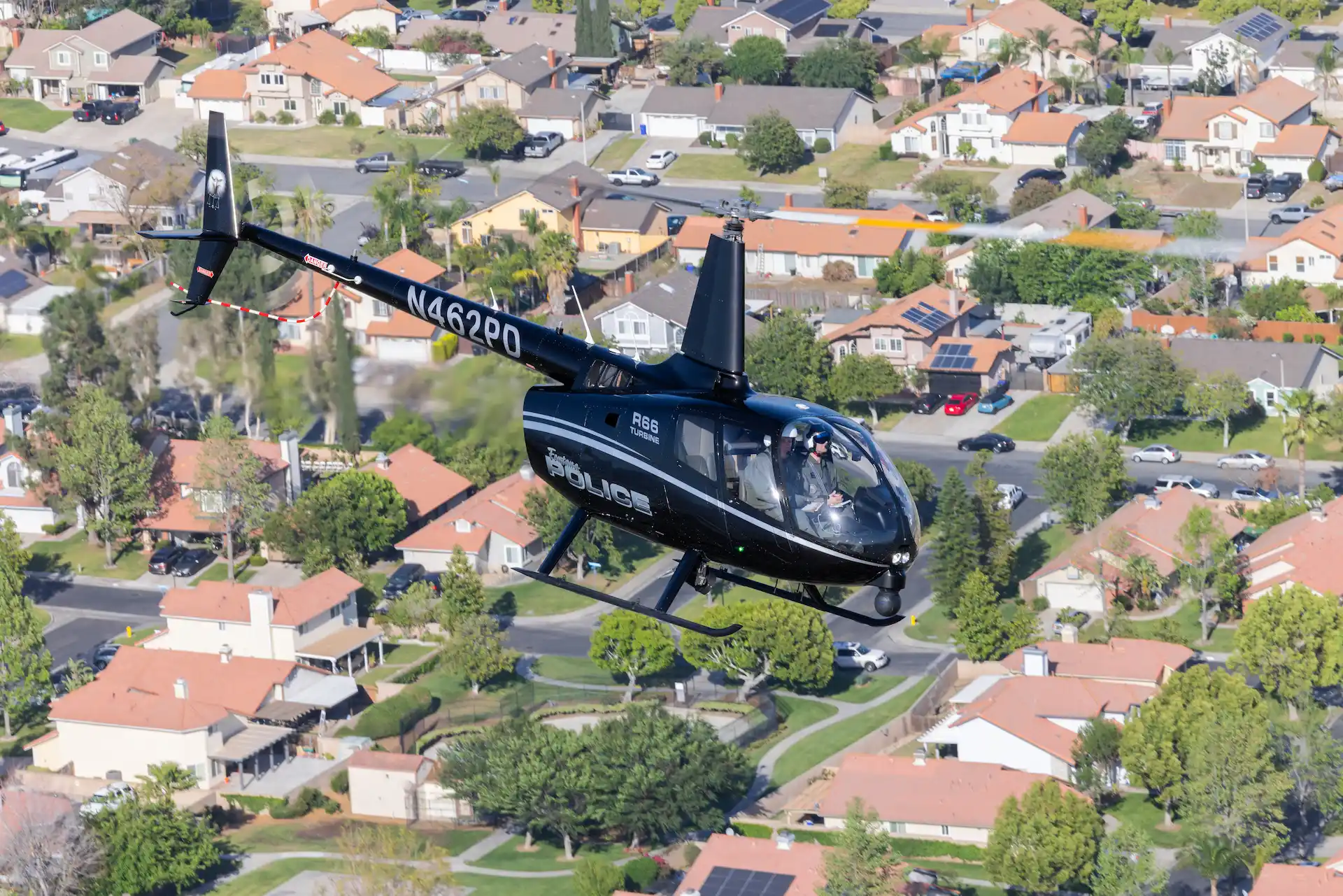
The Ultra 8000 multi-sensor system offers a high degree of infrared detection, integrating a 10X optical zoom infrared camera with a 18X optical zoom daylight camera. The 360 degree rotation and stabilization technology of the gimbal ensures the capture of high quality imagery. An auto tracker and long range camera are also available as options. Specific law enforcement equipment fitted to Fontana’s R66 includes a 750W xenon lamp, dual audio controller, multi-channel radio and an iPad. The air conditioning system includes forward and rear vents. The R66 Police version is produced at Robinson’s Torrance, California, facility and is specially configured to meet the requirements of law enforcement agencies. Available optional equipment includes a five-point harness system, public address system and siren, microwave downlink capability, LoJack tracking system and moving map systems. Also optional are UHF and VHF communications alongside the 800MHz police radios.
The searchlight and FLIR are commonly used to guide ground units to a location, look for missing or suicidal subjects or to track and locate suspects, and officers in the air can identify threats before ground officers are hurt, potentially saving officers’ lives. Large areas can be searched quickly, as the helicopter can be on location in a short time. Studies have shown that the constant and persistent presence of a patrolling helicopter suppresses crime, significantly reducing street crimes such as burglaries, robbery, and auto theft. The helicopter’s vantage point permits observation of activities not seen by ground officers, such as rooftops and fenced in yards. A useful maximum endurance of around two and a half hours on patrol leaves the Robinson with the required 20 minutes fuel reserve on landing.
The Robinson R44 that the program first started with was economical. A helicopter is never cheap, but in the grand scheme of things, it was fairly inexpensive and relatively easy to operate. One of the R44’s major advantages was its 2,000hr maintenance cycle. With other helicopters different components time-out at different intervals, so it was a very attractive platform for the Fontana Police Department starting from scratch. Once they decided to get into the regional program, they then looked at the R66 because in many respects it was almost the same as the R44. It was economical and a relatively inexpensive way to transition to a turbine engine. It retains the same 2,000hr maintenance cycle for all componentry and almost everything they liked about the R44 was replicated on the R66. The ease of operation, maintenance and training were the same, but the R66 is more expensive to purchase. Engine maintenance is minimal compared to the R44’s piston engine though, as a turbine eliminates adjustments to and maintenance of such items as valves and timing, carburetors and magnetos. The turbine is subject to programmed interval inspections and that's pretty much it. It was therefore an easy decision for the Fontana Police Department to go with the R66.
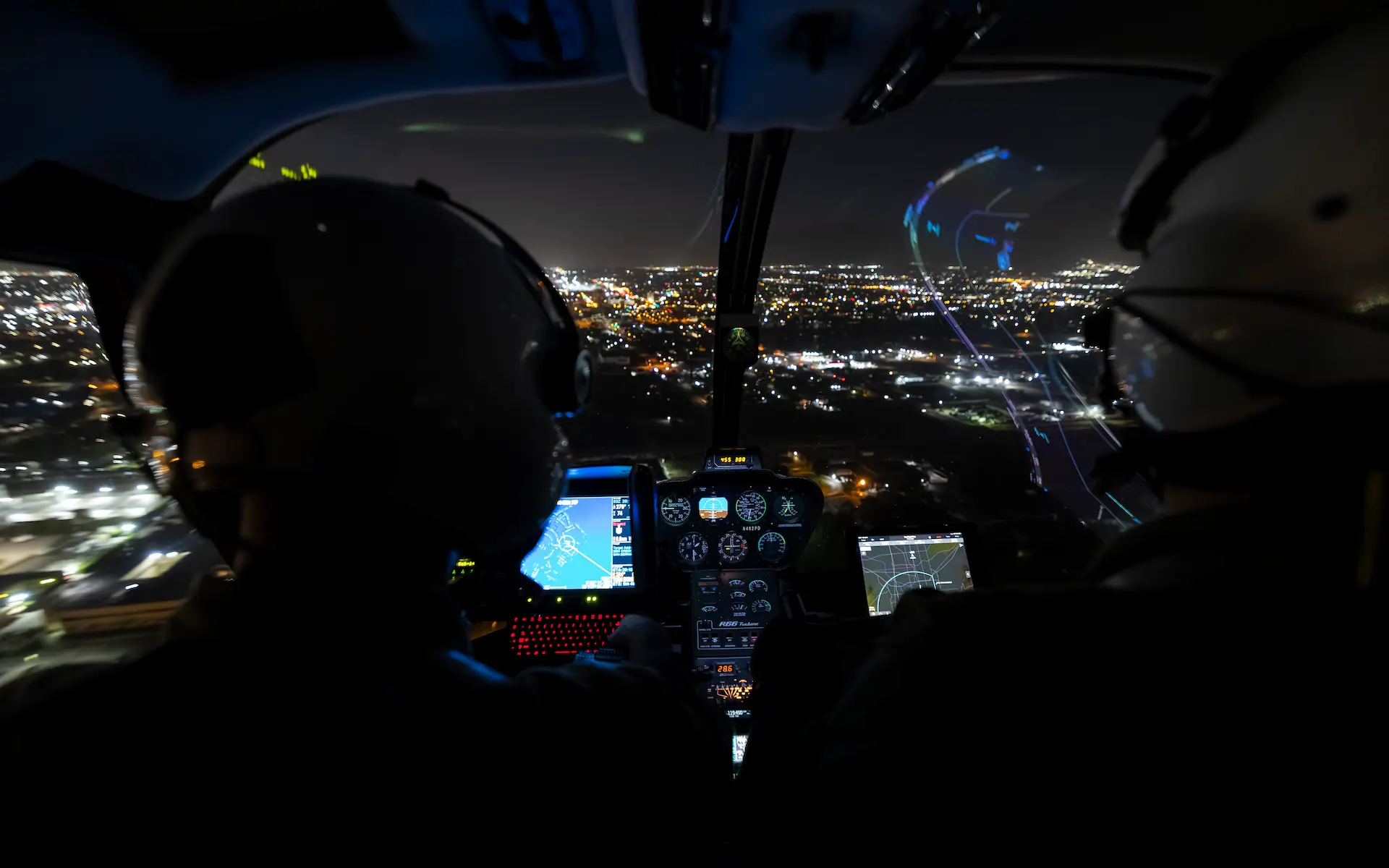
Fontana police officer Ryan Wyndaele is currently assigned to the Air Support Unit as a TFO. The TFO handles radio communication, is an observer, a system operator and handles other police equipment in the aircraft. Wyndaele has been in the Fontana Police Department for eight and a half years and active as a TFO for almost a year and a half. He likes the fact that the R66 is a little smaller, and described the visibility out it as fantastic, commenting, “When we’re flying, in all of those pursuits with guys running everywhere, I can see everything out the window.” Wyndaele is a full-time TFO. He has extensive experience within the Fontana Police Department so, although he is quite capable of hopping in a police car and taking patrol calls, when he shows up to work he’s on the schedule for the helicopter. Wyndaele keeps a running log of all calls attended, recording how many arrests they assisted in and how many ground units they were able to cancel. What these measurable, quantifiable records don’t and can't show is how many times the helicopter’s presence discouraged an offender from committing further, more violent offences.
Fontana Police bought a second R66 in 2014 and sold the R44, so the fleet currently comprises two R66s, ‘Eagle-1’ and ‘Eagle-2’, but they are in the process of adding an AS350-B2 A-Star formerly operated by the Ontario Police Department, with which Fontana has a close working relationship. Fontana arranged the funding for the A-star and before purchasing it they talked to Ontario’s mechanics that maintained it and the air crews that operated it to obtain a complete picture of its history and condition. When you buy a Robinson police helicopter it is new from the factory and comes with the FLIR, the computers and all the police equipment. With a used machine like the A-Star however, you usually have to buy the machine and then send it to another company for completion and installation of the police equipment. However, because the A-star is a proven ex-Ontario Police law enforcement aircraft, it is ready to go with the FLIR, search light, loud speakers and other equipment aready fitted. Fontana will spend $2.8 million in American Rescue Plan funds on the previously-owned helicopter to bolster public safety and fire and emergency medical services.
The plan is to keep both R66s and operate three aircraft. The sergeant was in charge of buying the A-Star, which will be the flagship of the Fontana Police Department. The larger, heavier machine is a much more stable platform in high winds so it will be the first choice aircraft in such conditions, a major factor in the decision to purchase it. The agency is going to keep both R66s because they are already paid off. One of them has about 500 hours before overhaul and will be out of service for quite some time, so adding the A-Star to the fleet means they will still have two serviceable airframes available, and that advantage will apply in the future when other maintenance and overhaul schedules take a machine out of service. The A-Star is better suited to working with the narcotics or gang units as it has better equipment, including a downlink system that can trasfer realtime data to the police station or city hall during critical incidents. It can stay on surveillance at a higher altitude and further away from the crime scene. Both helicopters have a Vne (never-exceed speed) limit of 130kts, although that reduces to 120kts when fully fuelled and heavy. The San Bernadino County Sheriff aircraft is able to fly faster in higher winds and there have been times that San Bernardino has launched for the same pursuit at the same time and beat Fontana’s R66, which was too heavy and a little slower. The Robinsons can't go above 70 knots in the high winds and that’s a major operational drawback for them.
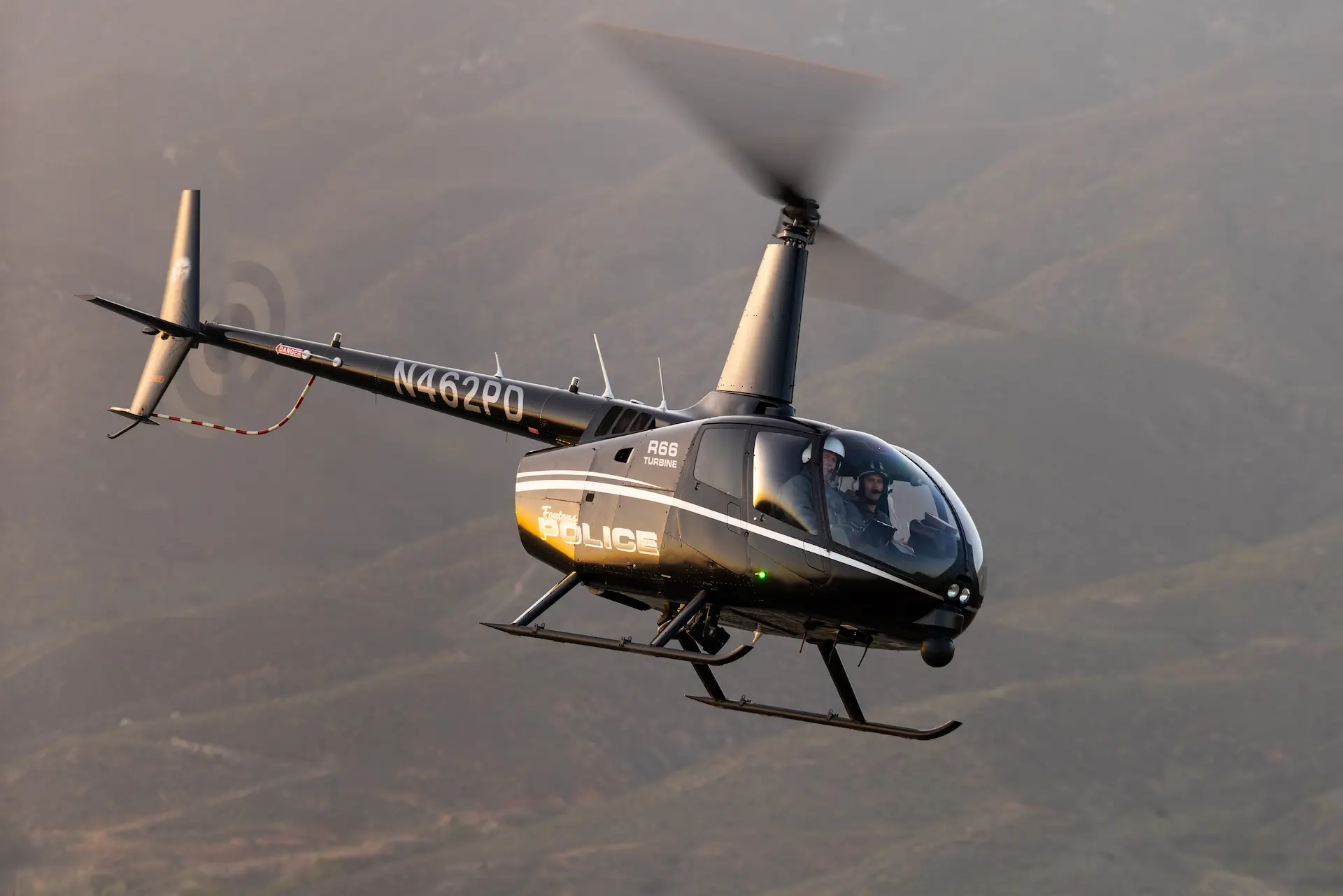
Mountains lie to the north of Fontana, with a mountain pass just north of the city. The strong seasonal Santa Ana winds come through that pass and blow across Fontana with gusts of up to 45 or 50 knots at times. The R66’s two-bladed rotor system can be susceptible to mast bumping in such turbulent conditions and there have been many occasions when the helicopter couldn’t safely launch. Shootings, officers involved shootings, car chases and other crimes have been underway and the helicopter could not attend because weather conditions made it unsafe. Winds have historically cost the department approximately 30% of its flight time in the Robinsons and the more capable A-Star should substantially reduce that percentage. They can't put a price on that. The A-Star’s three-blade rotor system mitigates the possibility of mast bumping in that low-g turbulence condition and, although it will still be uncomfortably bumpy, officers can be airborne and more effective in higher winds. The increased capabilities of the AS350 make firefighting support a viable mission for the Fontana air support unit and the A-Star will be fitted with firefighting equipment utilizing a 216gal Bambi Bucket.
The A-star has a FLIR under the nose, an arrow computer moving map system, a searchlight and a loudspeaker. Its Technisonic police radio monitors three frequencies at once. The Robinsons are a little more sensitive as far as weight is concerned and back then the smaller equipment wasn't as good as larger versions. Fontana Police are very effective with the R66 equipment, but it is dated. Although the A-Star is about the same age, virtually all the equipment in it is upgraded. The radios, the FLIR system, the camera, all of it. Fontana doesn't use the daylight camera on the R66s, using binoculars instead as they find them more user-friendly and accurate. The daylight camera on the A-star is much better however. A major advantage of the A-Star is that it can operate effectively from higher overhead scene calls. The Robinsons are effective but have to operate a lot lower, particularly to read license plates with binoculars. The A-Star’s longer-range FLIR and cameras are significant for the crew because the higher altitudes they enable keep them out of the trees and power lines, making the A-Star a safer platform.
Police helicopters can be invaluable in certain situations. Fontana’s policy specifies situations where the use of a helicopter may be requested and the protocol for making a request. If a supervisor or officer in charge of an incident determines that the use of a helicopter would be beneficial, they may request such assistance. After consideration and approval of the request, the watch commander or his/her designee, will call the closest agency having helicopter support available and apprise that agency of the specific details of the incident prompting the request. A police helicopter may be activated under existing mutual aid agreements, or requested if the safety of law enforcement personnel is in jeopardy, to aid in the capture of a fleeing suspect whose continued freedom represents an ongoing threat to the community, to locate a person who has strayed or is lost and whose continued absence constitutes a serious health or safety hazard, or to assist in vehicle pursuits. While it is recognized that helicopter support generally provides valuable assistance to ground personnel, the presence of a helicopter will rarely replace the need for officers on the ground. The helicopter aids the patrol officer on the street and assists in progress calls, robbery, shooting and burglary calls, foot pursuits, vehicle pursuits, lost persons, injured hikers, fires; basically any call at which it can add effectiveness or increase safety. The helicopter’s quick response time results in more arrests and recovery of stolen property. It provides an an aerial platform for photography, aerial surveillance and disaster response.
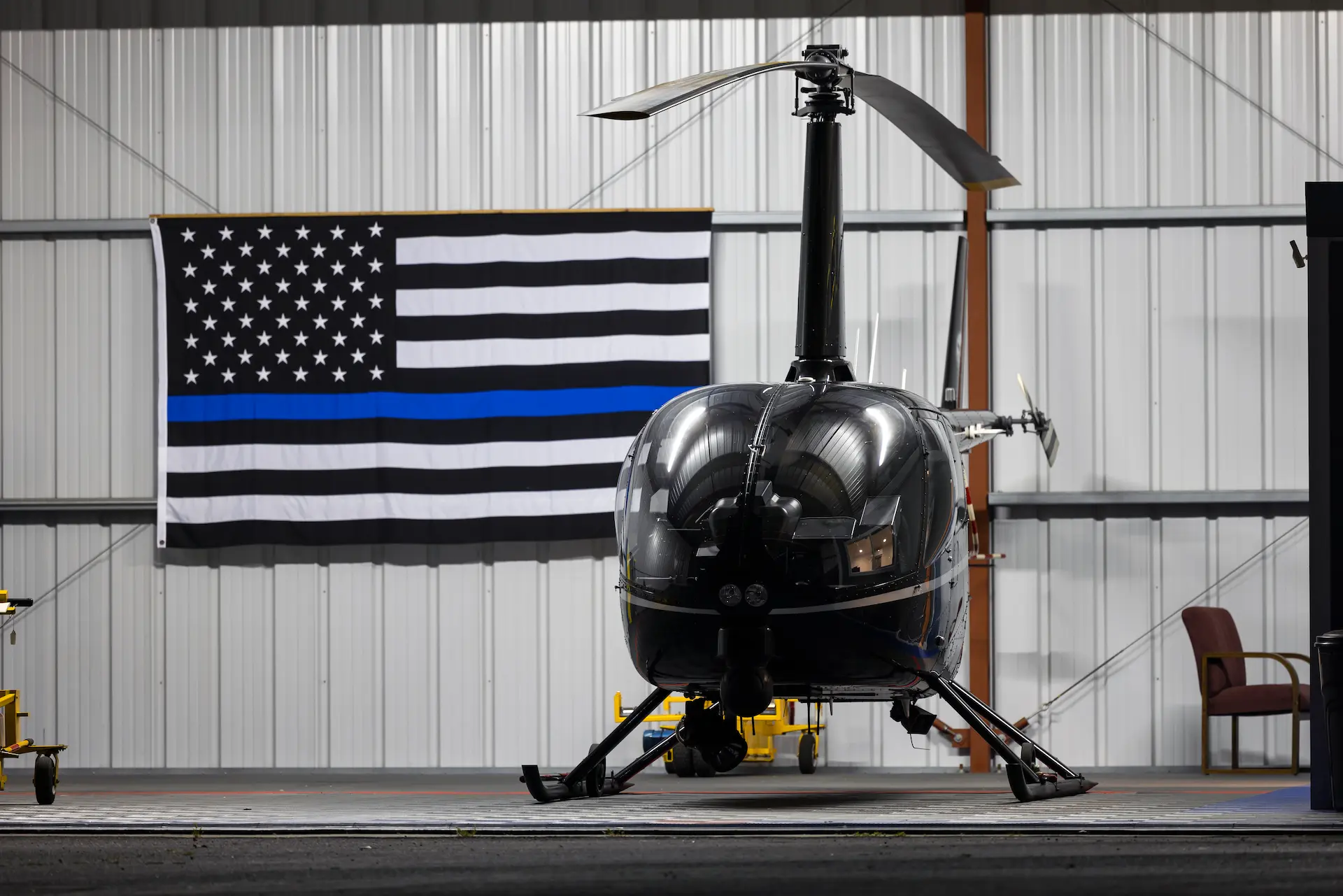
One of the pilots is a retired police officer with 20-plus years experience in another agency in the area, while the other pilot is a civilian and a third civilian pilot is in training. Aside from a CPL, minimum hours and turbine rating requirements, applicants for the police pilot’s role must demonstrate excellent crew coordination. They initially fly in the backseat on active missions, with the full-time pilot and TFO up front. Then they transition to a front seat under training by an experienced pilot. With the ex-police pilot, the new pilot also gets the benefit of TFO knowledge and training. Obviously Fontana signs the paychecks so Fontana is the main focus of the air unit, but a sworn police officer in California is a police officer in the entire state. San Bernardino County Sheriff, Ontario Police and Fontana all operate in the area and all support requests for air support from other agencies within the area. They have the radio channels for all agencies in the county.
The Fontana Police have a department dedicated solely to tracking crime patterns. The busiest times are Wednesday, Thursday, Friday and Saturday, from 1:00pm to about 11:00pm, so the helicopters were running only at those times. Some of the patrol sergeants recently requested extended operating hours however, as pursuits and fights were on the increase at later times and as a result, the helicopter now operates from 3:00pm to 1:00am on Fridays and Saturdays. Although the schedule is largely fixed, there is a degree of flexibility to accomodate circumstances and incidents outside those hours. The crew is always willing to accommodate and last year, for example, they had riots in the area and spent a lot of overtime flying over the riots as an eye in the sky. Fontana would certainly like to extend the air unit’s operating times. The City Council, the ground officers and the citizenry are all happy with the air unit. The A-Star will offer a lot more mission capability so the main goal is to get more coverage, with more personnel doing the job. Law enforcement air support is an invaluable tool and the more it is overhead, the more likely it is that citizens, suspects, and police are going home safely.
 HOME
HOME


